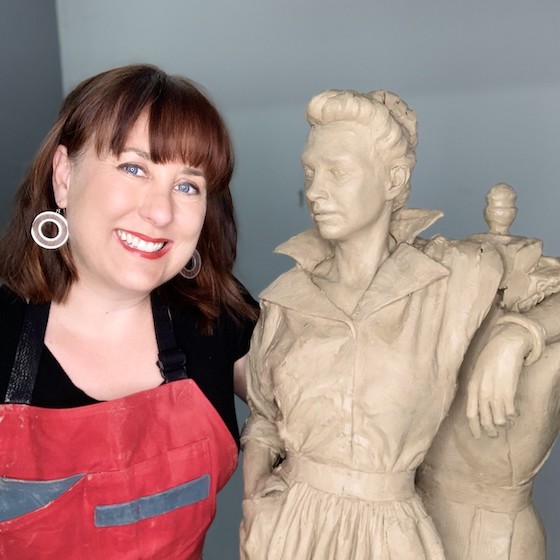Sculpting the Past | Sarah Hempel Irani, M.A.'11

Hood alumna Sarah Hempel Irani discusses her work, the importance of arts education and the Claire McCardell Project.
Sarah Hempel Irani, M.A.'11
Graduation Year
2011
Program
- Humanities (M.A.)
Department
- Art & Archaeology
- English & Communication Arts
- History
Degree
Humanities, M.A.
Title
Sculptor
How did you become involved in the arts, specifically with sculpture?
While I had always been interested in art, I was placed in a sculpture class as a freshman in college. It was the most challenging art class I had ever taken and I quickly became obsessed with it. Sculpture combines my interest in the figure, anatomy, art history and building things. It felt like I was made for it!
What made you decide to study at Hood? What are the biggest takeaways from your time as a student here?
I moved to Maryland from Michigan in order to work as an apprentice for Jay Hall Carpenter, who is the former artist-in-residence at the Washington National Cathedral. After working in his studio, I set off on my own and established a sculpture studio in Frederick. I needed a part-time job and there just so happened to be an opening in the slide library in Tatum. I had worked in a slide room previously, so it was a good fit. While I was working at the slide library, I had the opportunity to take some classes. I was so taken with the quality of the classes and the caliber of the professors that I applied for the humanities program. The work that I do—public art as well as statuary for churches—is informed by the history of art and ideas. While I was at Hood, it was a rich educational experience, as well as a supportive community.
Why do you feel the arts are important in education? What advice would you offer someone considering a career in the art world?
I often quote Elbert Hubbard: “Art is not a thing; it is a way.” I see art—and I mean all the arts—as a way of sinking into what it means to be human. We have this incredible gift as humans. Creativity is an antidote to destruction. Think about this for a moment: we are destroying the world on so many levels, but what is the opposite of destroying? It’s creating! When we create, we bring beauty and honesty to the world. Being a professional artist is a huge challenge, no doubt, but I have learned that it is not because there is anything wrong with artists per se. The system set up to support artists is dysfunctional, but at the heart of being an artist is being a creative problem solver. There are many ways to be an artist in the world.
Tell us about your involvement with designing the new Claire McCardell statue in downtown Frederick.
In celebration of their 120th anniversary, The Frederick Art Club invited me to create a monument to commemorate renowned American fashion designer and Hood alumna, Claire McCardell. It has been a two-year journey, but we are unveiling the completed 7’6” bronze monument on Sunday, October 17!
Your work is inspired by the female body. What can people do to push for greater representation of women in the arts?
Public art has always been political. Creating monumental bronzes for public spaces is a time-consuming and expensive endeavor. Historically, these kinds of monuments have been commissioned by people in power—whether kings or nobles, captains of industry or religious organizations. Since much of history has excluded women in power, the decision for who is commemorated has been up to committees of powerful men. That is changing as women’s voices have been amplified and women’s achievements are being recognized. The Claire McCardell Project is a wonderful example of what can be achieved through cooperation. The Frederick Art Club inspired folks throughout the community to contribute to this vision, no kings or noble lords involved! In order to get more women up on pedestals, we need more women on decision making boards and community groups like the Frederick Art Club to take action.
As with most things, education plays an important role. For example, very few people know that only 10 of the 100s of statues in Washington, D.C. are of real, historical women. Art history—my focus while at Hood College—tends to be relegated to elective status, but it teaches us so much about our own past. In order to understand a work of art, you must understand the period in which it was created, the power structures, prevailing philosophies, religious beliefs, and the technology and aesthetics of the time. The more we know, the better we can do.
Learn more about Sarah’s work here.
Are you ready to say Hello?
Choose a Pathway
Information will vary based on program level. Select a path to find the information you're looking for!
